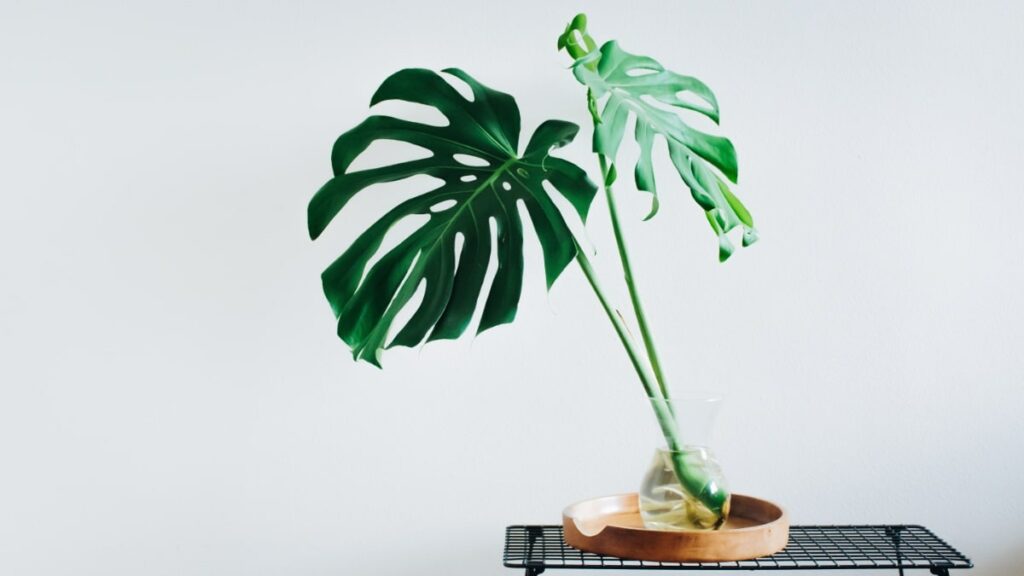Monsteras have become a household staple among plant collectors. Whether you love the all-green Monstera Deliciosa, or obsess over the variegated Thai Constellation or Albo variants, these plants are in incredibly high demand. New growers may not realize how simple it is to create new Monstera plant cuttings at home for gifts or growing a plant collection. Propagating a Monstera through stem cuttings is a fascinating process that requires some expertise, but is incredibly easy to learn. In this guide, we’ll show you how to propagate a Monstera plant to grow your own plants.
Introduction to Monstera Deliciosa Propagation

The Monstera Deliciosa, also known as the Swiss Cheese Plant, is a beloved houseplant that is adored for its distinctive foliage and low-maintenance nature. This tropical plant is indigenous to Central and South America and can reach towering heights of up to 10 feet in its natural habitat. Not only do they have stunning foliage, Monsteras have easy care requirements and are incredibly forgiving plants, making them a great choice for both veteran growers and those just starting their plant collection journeys.
If you’re looking to expand your plant collection or share the joy of this stunning plant with your loved ones, propagating a Monstera Deliciosa is an excellent way to do so. In this article, we’ll cover a few methods of propagating a Monstera Deliciosa and provide you with step-by-step instructions to ensure that you can successfully propagate your own plant. Whether you’re a seasoned plant parent or a novice, propagating a Monstera Deliciosa is a fun and fulfilling experience that will allow you to bask in the beauty of this magnificent plant for years to come.
🌿Note: We’ll focus on taking cuttings of the Monstera Deliciosa for this walkthrough, but you can use the exact same steps to propagate other variants like the Thai Constellation or Albo too!
Understanding Monstera Deliciosa Anatomy
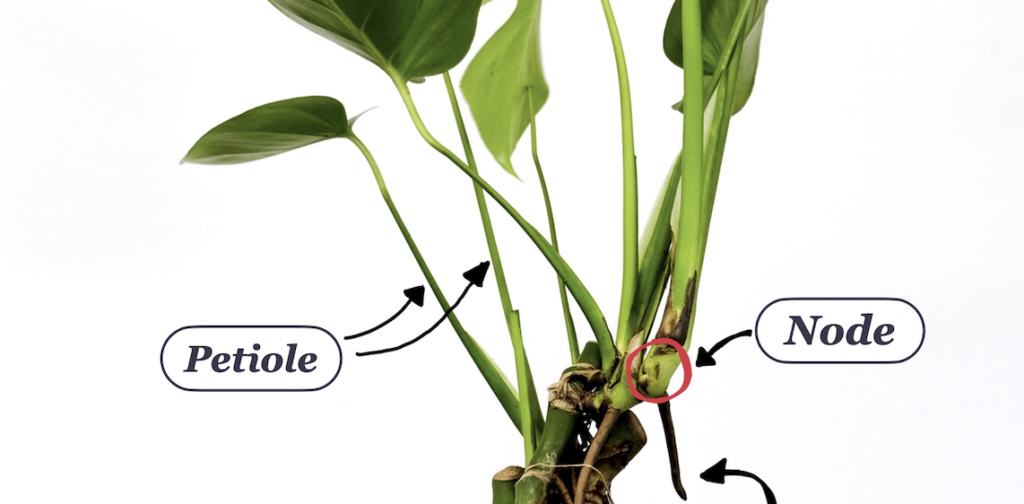
Before we sharpen our shears, let’s take a pause to get an understanding of the Monstera’s anatomy. This will help identify the healthiest segments of the plant so your cuttings have the best chance at surviving.
The Monstera Deliciosa is a vine made up of different modular segments called nodes. Think of each node as a self-contained mini-plant. Each node segments contains an aerial root, petiole stem, and leaf. Node segments have very distinct markings around the circumference where you can usually find the aerial root bump.
Usually, the node is defined by where the stem meets the vine, and the node segments continues until the next oldest leaf. Each of these segments contains everything the plant needs to create a genetically-identical plant should a break in the vine occur.
🌱Dive deeper into Monstera anatomy with our in-depth guide >
When propagating a Monstera Deliciosa, it is crucial that your cutting includes at least one complete node segment from the main vine. Plants can be propagated with multiple node segments, but you’ll need at least one complete node in order to successfully grow a new plant.
Nodes don’t necessarily need to have pre-formed aerial roots, although if they have roots that are at least 1″ long, this will jumpstart the process. We’ll cover more in the steps, but keeping this in mind will help enable you to determine where to make your cut and where to plant the cutting.
A thorough comprehension of the anatomy of a Monstera Deliciosa is not only essential for successful propagation, but it is also vital for proper care. Knowing the location of the aerial roots will allow you to provide the plant with the necessary support it requires to flourish and thrive.
Choosing the Right Propagation Method

When it comes to the propagation of a Monstera, there are a plethora of methods to choose from. The most common methods include stem cuttings, air layering, and division. Each method has its own unique set of benefits and challenges, making it important to choose the right one for your specific needs.
Stem Cuttings
Stem cuttings are the easiest and most popular method for propagating a Monstera. In fact, it’s what we recommend for virtually all situations given how easy it is, and how high of a success rate we’ve had going this route. This method involves cutting a stem with a few leaves attached and placing it in either water or soil. It is important to cut just below a node, which is where the leaves attach to the stem, in order to encourage new roots to grow. However, this method may not be suitable for all plants, as some may require a more advanced approach.
Air Layering
Air layering is a more advanced method that involves creating a small wound on the stem and wrapping it with moist sphagnum moss. This technique encourages roots to grow from the wound, and once they have developed, the stem can be cut and planted in soil. While this method may be more challenging, it can be highly effective for rarer Monstera plants and is recommended for more expert growers.
Plant Division
Division is another method that involves separating the plant into smaller sections and replanting them directly into soil. This method is best for larger, more mature plants that have multiple stems or a crowded root system. It can be a great way to rejuvenate an older plant and promote new growth.
When choosing the right propagation method for your monstera, it is important to consider the size and age of the plant, as well as your own level of experience and comfort with each method. Regardless of which method you choose, it is important to be patient and give your new plant time to establish itself before expecting significant growth.
Propagating Monstera Deliciosa through Stem Cuttings
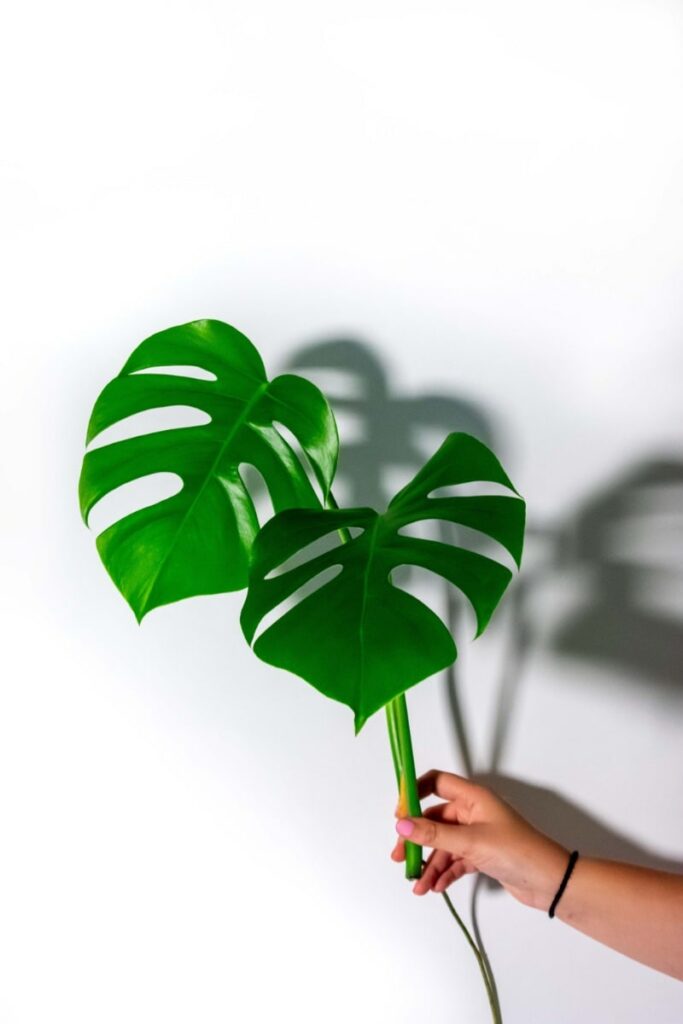
Our favorite way of propagating Monstera is through taking stem cuttings. As we covered in the above Anatomy section, Monstera plants are comprised of a vine with different node segments that are defined by pronounced rings around the circumference. Each node section has a stem, leaf, and root. You’ll need at least one complete node to form a new plant successfully.
Choosing Healthy Nodes
The first step is to look for nodes that have healthy stems and leaves attached, and ideally small aerial root nubs. If you’re looking to take cuttings from a large Monstera, know that you do not need to use every node segment, although taking multiple will increase your odds of success. You can also take a cutting that includes multiple nodes (and leaves). Larger cuttings tend to rebound faster, but we’ve had great success with single node segments as well.
Making the Cut
With your node segments in mind, use a sharp, clean pair of scissors or pruning shears to cut the vine at the node endings you identified above. You can choose to take cuttings of the entire Monstera, or just a few, leaving the mother plant to heal and create new growth.
Preparing the New Cuttings
Let’s get your new cuttings ready for their new life and give them the best possible chance at growing. If your cuttings contain multiple nodes, they may also contain multiple Monstera leaves. Feel free to remove all but the 1-2 newest leaves, including the petiole stem, if this makes the cutting easier to work with. This will encourage faster propagation. Since Monstera leaves are so large, having fewer leaves in the cutting will help the plant focus its energy on root production, helping the new plant form faster.
Adding Rooting Hormone
While not necessary, using a rooting hormone will encourage roots to form much faster. We recommend a powder-based rooting hormone for Monsteras. Place some on a spoon and after dipping the root ended cuttings in water, gently pat them on the spoon with the hormone. Allow the cuttings a few minutes to absorb the hormone before moving on to the next step. Note: never dip the cuttings directly into your rooting hormone container to ensure you do not spread bacteria to your supply.
While rooting hormone is not required, it will speed up the cutting process by several weeks. Because of this, we recommend picking up some rooting hormone to maximize the potential of your new plants.
Adding the Cuttings to Water
Fill a vase or other container with water that completely covers the root segments of your node. Be careful not add too much water so the vine node is completely submerged as this may lead to the plant rotting. Gently add in your cutting to the vase. You can keep multiple cuttings in the same container, or separate them depending on your personal preferences.
Providing Great Cutting Care
Keep the vase in a sunny spot as your new cuttings will need a lot of energy to form a new root system and transform from tiny nodes to completely new plants. Ensure the water level keeps the root segments submerged. Do a complete water change weekly to ensure your plant has clean water. In a few weeks, you should notice roots taking hold in the vase. This may take longer in colder, less humid or dimmer conditions, especially during more dormant winter months.
Time to Transplant
After a few weeks, you should see your Monstera cuttings develop small root systems. Once I notice secondary roots branching off of the main roots, it’s safe to bring the cuttings to pots with soil as completely new plants. Equal parts succulent soil mixed with orchid mix work best, and you can take a deep dive into our Monstera soil care recommendations here. Gently pot up your new Monstera plants and keep the soil moist for their first few weeks as they transition to becoming established plants. Make sure you’re paying attention to their lighting and water needs as your beautiful new plants grow!
While it seems like a lot of steps, knowing how to propagate a Monstera will quickly become second nature after just a few attempts. In time, you’ll have more Monstera plants than you know what to do with! Luckily, these plants make amazing statement plants and even better gifts for friends and family.
Propagating Monstera Deliciosa through Air Layering
When it comes to propagating Monstera Deliciosa, there are a variety of methods to choose from. One such method is air layering, which involves creating a small wound on the stem of the plant and then encouraging roots to grow from that wound. This technique can be a bit more time-consuming than other propagation methods, but it’s a great way to create a new Monstera Deliciosa plant without having to take a cutting.
To get started with air layering, you’ll need to choose a healthy stem that is at least 12 inches long and has several leaves. Once you’ve selected your stem, you’ll need to make a small cut about 6 inches from the tip of the stem. This cut should be about 1/3 of the way through the stem, and you’ll want to apply rooting hormone to the cut area to encourage root growth.
Next, you’ll need to wrap the cut area with damp sphagnum moss and then wrap it with plastic wrap to keep the moss in place. It’s important to check the moss periodically to make sure it stays damp, as this will help to encourage root growth. After a few weeks, you should start to see roots growing from the cut area.
Once the roots are about an inch long, you can cut the stem below the moss and plant it in a pot with well-draining soil. This new plant is more likely to thrive once it’s planted, as it already has roots.
Overall, air layering is a great way to propagate Monstera Deliciosa, and it’s a technique that’s definitely worth trying if you’re looking to create a new plant. With a bit of patience and care, you can successfully propagate your Monstera Deliciosa and enjoy the beauty of this stunning plant for years to come.
Propagating Monstera Deliciosa through Division
If you’re looking to propagate your Monstera Deliciosa, there’s another method you can try: division. This technique is particularly useful for mature plants that have outgrown their current pot or have multiple stems. Here’s how to do it:
Step 1: Find a healthy and mature Monstera Deliciosa plant with multiple stems.
Step 2: Gently remove the plant from its pot and carefully separate the stems.
Step 3: Using a sharp knife or pruning shears, cut the stems into sections, ensuring that each section has at least one leaf and a healthy root system.
Step 4: Plant each section in a separate pot with well-draining soil and water thoroughly.
Step 5: Place the newly potted Monstera Deliciosa in a bright and warm location, but avoid direct sunlight.
Step 6: Keep the soil moist but not waterlogged and mist the leaves regularly to maintain humidity.
Step 7: Keep a close eye on the new plants and ensure they are growing well.
By propagating through division, you can create new Monstera Deliciosa plants while also keeping the original plant healthy and well-maintained. With proper care and attention, your new Monstera Deliciosa plants will thrive and grow into beautiful and lush specimens.
Caring for Newly Propagated Monstera Deliciosa
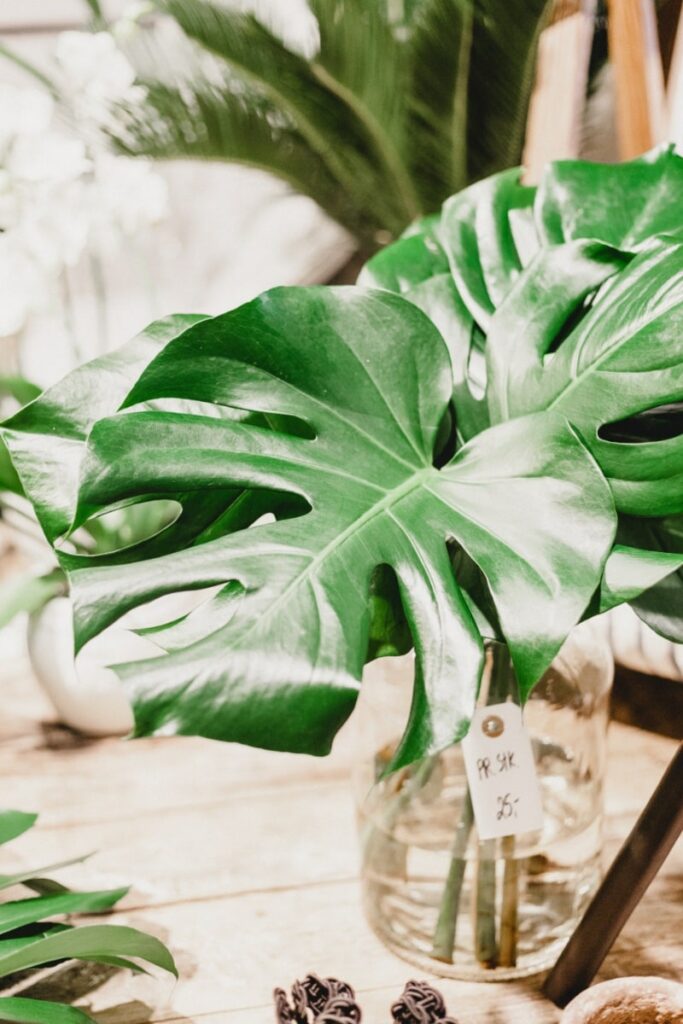
When it comes to caring for your newly propagated Monstera Deliciosa, there are a few key factors to keep in mind. First and foremost, watering is crucial. You’ll want to make sure that the soil stays moist, but be careful not to overwater as this can lead to root rot. Keep an eye on the top inch of soil and water when it feels dry to the touch.
In addition to watering, light is also important. Monstera Deliciosa thrives in bright, indirect light, so be sure to place your newly propagated plant in a spot that receives plenty of filtered light. Direct sunlight can be harmful and may scorch the leaves.
Another factor to consider is humidity. Monstera Deliciosa prefers high humidity levels, so you may want to invest in a humidifier or place a tray of water near the plant to increase the moisture in the air.
When it comes to fertilizing, it’s important to give your newly propagated Monstera Deliciosa time to establish its roots before introducing any fertilizer. Once the plant has started to grow, you can begin fertilizing with a balanced fertilizer every two weeks during the growing season.
Finally, pruning can help encourage bushier growth and remove any yellow or damaged leaves. Pinch off the tips of the stems to promote branching and keep your Monstera Deliciosa looking its best.
By following these tips and giving your newly propagated Monstera Deliciosa the care and attention it needs, you can ensure that it grows into a healthy and thriving plant with beautiful, lush foliage.
Troubleshooting Common Propagation Problems
Here are some common propagation problems and how to address them:
1. To prevent root rot, it is important to use well-draining soil and avoid overwatering. If you notice signs of root rot, such as yellowing leaves or a foul odor, it is important to remove the plant from the soil and trim away any affected roots. Repot the plant in fresh soil and water sparingly until it has fully recovered.
2. Lack of Growth: If your monstera isn’t growing as quickly as you’d like, it may be due to a lack of nutrients. Make sure to fertilize your plant regularly with a balanced fertilizer, and consider adding a slow-release fertilizer to the soil. Additionally, make sure your plant is getting enough sunlight and isn’t being overcrowded by other plants.
3. Check the soil moisture level and adjust your watering schedule accordingly. If the soil is too wet, allow it to dry out before watering again. If the soil is too dry, water more frequently or consider adding a humidifier to the room.
4. Pest Infestations: Monstera plants are susceptible to a variety of pests, including spider mites, mealybugs, and scale insects. If you notice signs of pest infestation, such as yellowing leaves or sticky residue on the leaves, treat the plant with an insecticidal soap or neem oil. Make sure to follow the instructions carefully and repeat the treatment as necessary.
Conclusion and Final Thoughts on How to Propagate a Monstera
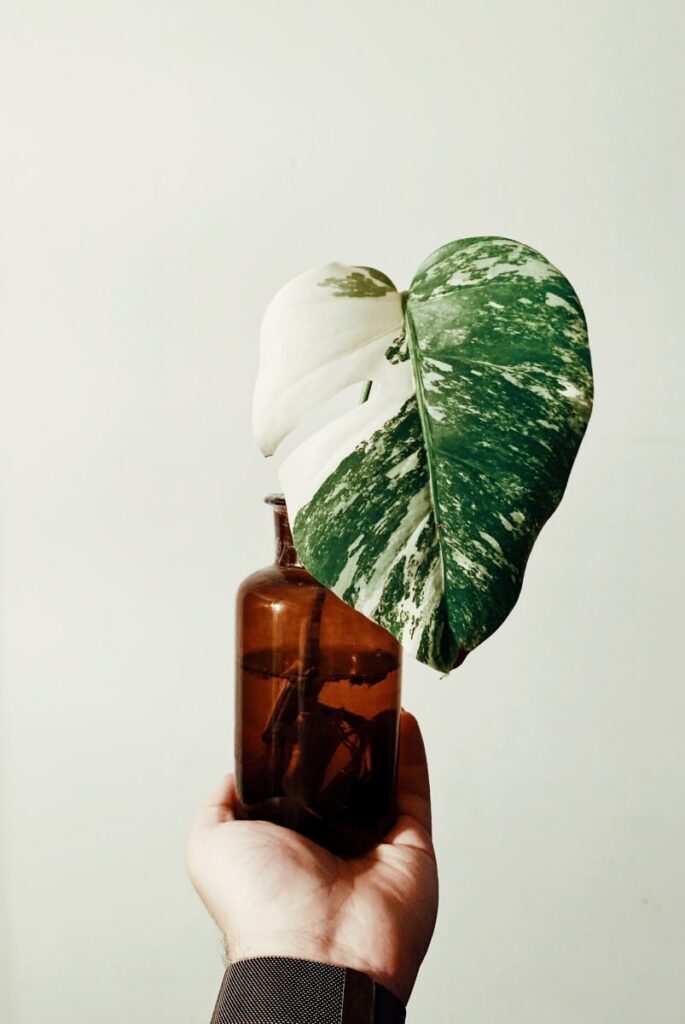
The process of propagating a Monstera Deliciosa is a fascinating and fulfilling endeavor that can be accomplished with a little bit of patience and care. Whether you choose to propagate through stem cuttings or air layering, the key is to provide your plant with the right conditions to encourage healthy growth.
It is important to keep your cuttings or air layers in a warm and humid environment, and to provide them with plenty of light and water. With time, you will see new roots and leaves begin to form, and your Monstera will start to thrive.
Propagation is not only a great way to expand your plant collection, but it is also an excellent opportunity to share your love of Monstera with others. You can give away cuttings to friends and family, or even start your own Monstera collection by propagating multiple plants from a single parent.
Overall, propagating a Monstera Deliciosa is a fun and rewarding experience that can help you grow your plant collection and share your love of these beautiful and unique plants with others. Now that you know all of the ways on how to propagate a Monstera, why not give it a try and see what kind of new growth you can achieve?
How to Propagate a Monstera: Frequently Asked Questions
How do I propagate a Monstera?
There are a few different methods for propagating a Monstera, but the most common is by stem cuttings. Simply cut a stem with a few leaves attached and place it in water or soil until it develops roots.
When is the best time to propagate a Monstera?
The best time to propagate a Monstera is in the spring or summer when the plant is actively growing. This will give the cutting the best chance of developing roots and thriving.
How long does it take for a Monstera cutting to root?
It can take anywhere from a few weeks to a few months for a Monstera cutting to develop roots. This will depend on factors such as the temperature, humidity, and amount of light the cutting is receiving.
Can I propagate a Monstera from a leaf?
No, it is not possible to propagate a Monstera from a leaf alone. You will need to take a stem cutting with at least one vine node in order to propagate the plant.
Do I need to use rooting hormone when propagating a Monstera?
While rooting hormone can help speed up the rooting process, it is not necessary when propagating a monstera. The plant is able to develop roots on its own as long as it is given the proper care and conditions.
Do propagated Monstera plants keep leaf fenestrations?
Yes! If you propagate a Monstera cutting that has a large, mature leaf with fenestrations, all new leaves will also develop fenestrations. This is a great “shortcut” to make smaller plants that keep the signature Monstera look.

